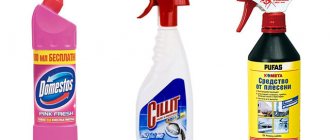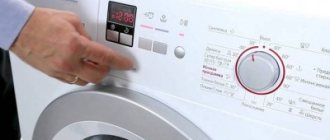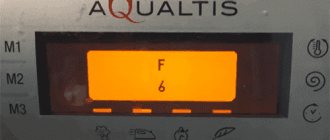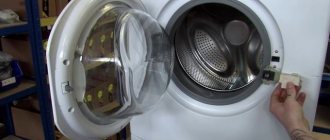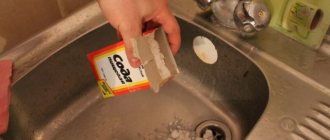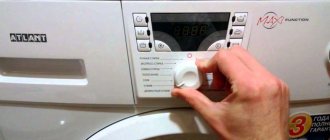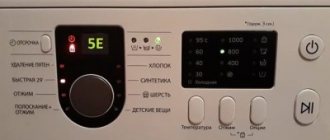How to clean the rubber band in an automatic washing machine from dirt. SMAs effectively replace manual labor and make the life of housewives easier. To ensure that the equipment does not fail, it requires proper care.
Periodic cleaning of various elements is a reliable prevention of breakdowns. The sealing cuff is no exception. In order not to one day find stains or smell mold, the rubber seal must be properly cleaned.
- Causes of unpleasant odors, scale formation, and mold
- Where to start cleaning the sealing rubber?
- Mold removal procedure
- Ways to eliminate odor and scale
- Treatment of the MCA cuff
- Cleaning compounds
- Preventive actions
- Catalog of washing machines with reviews
Causes of unpleasant odors, scale formation, and mold
When bacteria and fungus spread inside the equipment, a plaque is created and an unpleasant odor appears. Ideal conditions for the life of microorganisms are heat, dirt residues, high humidity and lime deposits.
If you always wash things at low temperatures, and also use the quick wash mode, disinfection does not occur, microorganisms do not die, but favorable conditions are created for their reproduction. To prevent this from happening, after each cycle you should thoroughly wipe the cuff and the inner surface of the drum.
Washing machine cuff with mold
Don't skimp on bleach. If processing of things occurs in its constant absence, then this also negatively affects the condition of the gum. It is a bad habit to store dirty things in the drum or keep the door closed all the time.
Expert opinion
I work in the household appliance repair industry. Extensive experience in restoring washing machines and dishwashers.
Ask a Question
Many rinses create plaque, which is a favorable environment for the life of various fungi and bacteria.
The main causes of plaque:
- operation at temperatures not exceeding 60 OC;
- excess rinses or gels;
- unsatisfactory powder quality;
- lack of regular care;
- high humidity;
- storing used laundry in a drum.
The reason for the formation of lime deposits is poor water quality, its hardness and excessive content of mineral salts.
How to clean dirt from a washing gum
You can properly clean the gum using different means, depending on the degree of contamination:
- a light coating will be removed by soap solution;
- A vinegar solution can handle moderate stains;
- Heavy dirt and even mold can be removed from the cuff by treating it with a solution of blue or bleach.
The principle of cleaning the rubber cuff is the same, regardless of what product you use. First you need to wipe it outside, then inside, pulling and processing all the folds. Apply a generous amount of detergent or disinfectant to the rubber band, close the door and leave for 30 minutes. Finish cleaning by running the washing machine in rinse mode.
If there are traces of nail polish or felt-tip pen on the body of the washing machine, you can remove them by wiping with a cloth moistened with alcohol or nail polish remover.
A dirty door sight glass can be easily cleaned using:
- glass cleaning products;
- regular wet wipes;
- hard sponge and dishwashing detergent;
- toothbrush and soda solution;
- a mixture of vinegar and soda.
And the most persistent stains formed as a result of long-term accumulation of soap scum can be dealt with with a Domestos solution or another chlorine-containing product. To do this, the selected product must be diluted with water and treated with glass, left for 5 minutes. and wash off.
The main consequences of mold: the appearance of dark spots on the sealing rubber and the unpleasant smell of mold in the washing machine drum, which is subsequently transferred to the washed items.
Mold cannot be ignored, as it is a direct breeding ground for various diseases. Several common causes of mold and mildew:
Washing clothes at low temperatures. This is strictly prohibited; it is better to alternate both operating modes and the temperature threshold.- Remaining water inside the drum. Liquid can remain in the washing machine only if its drainage system is not properly maintained and is clogged. A simple button causes constant moisture in the drum.
- Unclosed door. The seal not only prevents water from leaking out during washing, it also prevents air from entering the machine after the process itself. A little liquid and excess oxygen are a favorable environment for the appearance of harmful microorganisms.
Leaving water in the drum even once can lead to rapid mold growth. Therefore, the washing machine requires constant care and periodic inspection.
The washing machine is cleaned of harmful microorganisms, but if not used correctly, mold and mildew can return.
To prevent this, you should follow a few useful tips:
- Even if the washing machine drain is working properly, after washing the surface of the drum should be wiped dry with a dry cloth. Excess moisture not only leads to mold, but also shortens the service life of metal parts.
The ideal condition for the appearance of microorganisms is leaving wet laundry for an hour or two. To avoid this, laundry should be collected immediately after washing.- Do not leave water in the powder and bleach tray. After washing, take out the tray and wipe it dry with a cloth.
- The filter of the washing machine must be changed according to the instruction manual for the household appliance. A minimal delay will create favorable conditions for mold to grow.
- Periodic maintenance is a prerequisite for long-term operation of a washing machine. Therefore, 2-3 times a month you should wash your clothes at the maximum temperature setting.
Even if there is no mold on the rubber drum seal and other parts of the washer, it is necessary to wash it with citric acid and vinegar every six months.
We invite you to familiarize yourself with the Atlant washing machine leaking
This will help remove the breeding ground for harmful microorganisms, as well as clean all surfaces of the household appliance from scale and other deposits.
The cuff of the washing machine is designed in such a way as to protect the door from leakage, therefore it has several folds. During operation, drops of water enter here, creating a favorable environment for the development of fungi. Their accumulation (colonies) can be seen on the rubber band of the machine.
The problem occurs in every third housewife for the following reasons:
- continuous washing at temperatures up to 60°C;
- overdose of rinse aid;
- Frequent activation of modes without chemicals (super rinse).
The biggest problem is the lack of ventilation in the drum. If you close the machine door tightly after washing or like to keep wet laundry in the drum all night, don’t be surprised by mold on the elastic band.
Cleaning the seal is a difficult task. Numerous folds make it difficult to remove all the dirt; it often gets eaten into the rubber. Therefore, we will tell you what methods can be used to solve the problem.
Where to start cleaning the sealing rubber?
First of all, you should identify places where dirt collects and fungus has spread. The equipment is disconnected from the electricity, the door is opened and the rubber is carefully inspected, carefully turning away the folds around the entire circumference.
Particular attention must be paid to the lower part. It is best to do this immediately after the end of the next cycle, before the moisture evaporates.
Cuff
The outer part of the elastic is wiped with a damp cloth, then the folds are turned away and the indentations are processed. To work you will need:
- viscose napkin,
- foam sponge,
- rubber gloves to protect hands,
- cleaning gels or powders.
Do not use abrasives or chemical solvents to avoid damaging the seal material.
Choosing a Cleaning Product
How to clean the rubber band in the drum of a washing machine? Effective store-bought remedies, as well as proven folk methods, will come to the rescue. The most effective, according to many housewives, are:
- Chlorine-containing products – “Belizna”, “Domestos” and many others.
- Citric acid or lemon juice.
- Table vinegar.
- Copper sulfate.
- Antiscale.
- Liquid with acetone.
Before you start cleaning, you need to carefully inspect all the places where the fungus could hide. This includes a rubber seal near the door, trays with conditioner and powder, and a drain hose. Only after this can you decide whether it is worth washing the machine or whether it is better to replace damaged parts.
Mold removal procedure
The device is cleaned in several stages:
- wipe the surface with a damp cloth and remove plaque;
- turn away the edges and process the folds where dirt usually collects;
- put on gloves and soak a napkin in a chlorine-containing solution;
- clean the drum, as well as the inner and outer parts of the rubber;
- close the door and leave for 40 minutes;
- start the rinse mode and completely clean the device of chemicals.
Do you turn off the water tap after washing?
Oh yes! No.
Another effective way to save a car is to treat it with copper sulfate:
- A tablespoon of blue crystals is dissolved in one liter of water and the problem areas are carefully treated with the resulting liquid.
- The unit is left in this form for a day.
- To clean, turn on the quick wash mode at any temperature.
If there is too much mold, then the measures may not be effective enough. In this case, you will have to change the cuff. Please note that this is not easy to do on some washing machine models. The main reason is the non-separable case, or non-removable front panel.
Attaching the clamp to the cuff
Top 5 chemicals for cleaning rubber parts
Some of the most problematic contaminants occur just under the rubber seal.
You can clean these contaminants by removing the seal and washing it by hand. To do this, you need to use a screwdriver to pick up the wire clamp holding the rubber band and carefully remove it, then you can remove the rubber band itself. After this, it should be rinsed well under running water with a sponge and any mild cleaning agent or soaked in a basin with a bleach solution.
Our grandmothers didn’t have front-loading washing machines, but they knew how to fight mold. Various food acids and alkalis were used, which have the ability to kill microflora.
You will need two glasses of table vinegar (not essence). The sequence of actions is as follows:
- pour the solution between the folds of the cuff, close the door;
- start the machine in washing mode;
- after 5-10 minutes, press pause and leave everything standing for an hour;
- continue washing as usual;
- When finished, open the door and wipe the inside of the rubber band with a clean cloth.
If you suspect that vinegar remains in the folds, put the device on a quick wash, then check the cuff. As a rule, one procedure is enough to eliminate mold even in the most inaccessible places.
You will need ¼ cup of citric acid and 100 ml of water.
- Mix the ingredients.
- Using a toothbrush, apply the solution to the surface of the gum.
- Wipe with the hard side of a sponge or brush.
Now you can put the machine to rinse and enjoy the result.
We use soda
You can also clean the gum in the drum using baking soda, but the degree of contamination does not matter. Simply sprinkle this substance onto a sponge and wipe the inside and outside of the cuff. Repeat the procedure if necessary.
The good thing about this method is that the aggressive impact on the rubber is minimized. After cleaning, just put the machine on the rinse mode to get rid of unpleasant odors, mold and soda residues.
Next, we’ll figure out how to clean the dirt under the rubber band of a washing machine.
Before starting cleaning work, you must turn off the power to the washing machine to protect yourself from possible electric shock.
It would be a good idea to put on rubber gloves and get a few small rags that will be convenient for cleaning hard-to-reach surfaces. Never add solvents to the water you are going to use to wash contaminated areas - they can worsen the condition of the machine even more.
This is worth doing because there is a possibility that even after successfully removing the mold from the O-ring, the remaining harmful bacteria will return to the original location. If the result of the examination triples you, then you can proceed directly to processing the gum.
Experienced professionals advise disinfecting mold in several steps. First you need to apply detergent to a wet cloth and wipe the outside, and most importantly, the inside of the ring, getting rid of visible mold.
Next, you should carry out a cleansing wash in the rinse mode, without loading clothes into the drum, and then wipe it dry to prevent the possible spread of bacteria.
The first thing you need to do to combat mold is a thorough inspection of all work surfaces to identify all pockets of mold.
These surfaces include:
- drum door seal,
- washing powder tray,
- filter,
- water inlet and outlet hose.
In general, places that are constantly in contact with water. After processing and cleaning, these areas should be re-inspected.
Before using even safe products, you must wear household gloves.
Many housewives prefer to use table vinegar in the fight against harmful microorganisms, as a practical and inexpensive remedy. In terms of its effectiveness, vinegar is not inferior to expensive household chemicals.
Vinegar cleaning sequence:
Pour at least 200 ml of table vinegar into the bleach container. For convenience, you can use a measuring cup.- Start the longest operating mode and set the maximum temperature. Make sure the water in the washing machine is hot and the heating element is working properly.
- After finishing washing, pour 200 ml of vinegar into the container again. If desired, vinegar can be replaced with citric acid - it leaves a pleasant and fresh smell inside the drum. Start rinse mode.
- After the washing machine has finished working, you need to repeat the process and turn on the rinse mode again. Now you don’t need to add vinegar or add citric acid, just rinse everything with plain water.
- Once the repeat rinse is complete, you can open the door and wipe the inside of the drum clean with a dry cloth. Leaving wet spots is strictly prohibited.
The method is simple, fast, and does not require any costs. The main thing is to subsequently follow the operating rules of the washing machine and prevent the recurrence of mold on the rubber.
Lemon acid
The sequence of simple and quick cleaning of the rubber of a washing machine with citric acid:
- Preparation of the working surface. To do this, wipe the rubber seal over the entire surface with an ordinary damp cloth. You can also use a soft dishwashing sponge and a mild soap solution. Use a sponge or napkin to wipe off dirt and debris on the seal.
Coat the seal with cleaning agent.
It is best to use a household cloth with a denser structure. Soak the cloth in surface cleaner, then generously wipe the rubber around the drum cover. Hard-to-reach places should not be missed; this is the first breeding ground for mold and mildew.- Close the door tightly and leave the machine for at least 2 hours. After the specified time has expired, you can not wipe the seal, but simply start the washing machine in the “Rinse” mode. It's better to do this a couple of times.
- Add citric acid and turn on short-term operating mode at maximum temperature. After first making sure that the heating element is working properly.
After the above steps, the cleanliness of the rubber seal is guaranteed, you can safely start washing your clothes.
You can clean the rubber of your washing machine using products sold in every pharmacy: hydrogen peroxide and boric acid.
Hydrogen peroxide cannot be applied directly to the rubber; before the process, it must first be cleaned of mold. This drug is very effective - it kills the remains of bacteria that are not visible to the human eye, and then whitens the surface.
Hydrogen peroxide is the first enemy of paintwork. Do not apply to enamel or paint.
Before using boric acid, it must be diluted with plain water. After dilution, the solution should be applied to the rubber seal using cotton wool and left for 1-1.5 hours, then rinsed off.
Before applying boric acid, it is necessary to protect the skin; simple household gloves are suitable for this.
Baking soda
Baking soda is an inexpensive and practical way to remove mold from both rubber and paint surfaces.
Baking soda diluted in water (one teaspoon per glass of water is enough) will not harm paint or enamel.
It is enough to wipe the contaminated surfaces with a sponge or household rag several times, and then rinse off the solution with plain water.
If folk remedies don’t help, it’s time to turn to special household preparations. Top 5 products will remove mold or mildew quickly, permanently and inexpensively.
We suggest you read How to make your pants shrink after washing
A universal product that removes mold, various types of harmful microorganisms, and unpleasant odors. HG is more often used for cleaning tiles, but it is suitable for rubber and silicone products.
Mode of application:
- apply to mold or mildew,
- wait 1-2 hours,
- wash off with a damp sponge.
Price: from 400 rubles.
The combination of affordable price and effectiveness makes Tiret a very popular means for cleaning a washing machine from mold or mildew. The cost of 250 ml is only 200 rubles.
Mode of application:
- moisten the sponge in Tiret and wipe the infected area several times,
- leave for 30-40 minutes,
- rinse with clean water.
Blanidas
Blanidas belongs to the category of professional chemistry. Like HG, it is most often used to clean tiles and tiles, but can also be applied to rubber seals. Price: 400 rubles.
Mode of application:
- soak a sponge in Blanidas and wipe the infected area several times,
- leave for 1-1.5 hours,
- rinse with clean water.
Dr. Beckmann
Good quality product at an affordable price. Cost of Dr. Beckmann is only 300 rubles.
Mode of application:
- fill up the contents of one Dr. package. Beckmann directly into the washing machine drum,
- turn on the “Rinse” mode,
- After finishing work, wipe the inner surface of the drum thoroughly and dry.
A cheap but high-quality product for removing mold and mildew. In addition to cleansing, it also has a disinfecting effect. Price: 100 rubles.
Mode of application:
- apply to the contaminated surface,
- after 30 minutes, rinse with clean water.
Baking soda
Baking soda is the safest household chemical. It helps to cope with many contaminants, unpleasant odors and bacteria.
Method 1. For prevention. Dip a damp sponge in soda powder and walk over the surface of the rubber cuff from the inside and outside. In the rinse mode, remove any remaining soda from the drum.
Method 2. If mold is detected. Mix baking soda and water in equal doses and wipe all surfaces with the resulting slurry (drum, folds of the cuff and under it). Leave the machine with the door open for 1 hour, then, without rinsing off the soda, run the wash without laundry at a temperature of 60-70 degrees. The result will be better if you add a couple of dishwasher tablets to the powder compartment. Manually remove the remaining soda with a damp sponge, toothbrush or brush and start the rinse mode.
Ways to eliminate odor and scale
The easiest way to get rid of them is using available home methods. The following solutions are suitable for this:
- citric acid,
- chlorine bleach,
- soda or vinegar.
The surface is wiped from moisture and treated with a cloth soaked in a solution of medium concentration. The darkened areas are carefully cleaned with soda, after which the unit is started with an empty drum at 60 OC.
Do you store laundry in the washing machine?
Oh yes! No.
Special store-bought formulations or citric acid will help get rid of scale. It is added to the container in an amount of 100 grams and a long-term mode is started, setting the temperature to at least 60 OC.
Another way is to add 60-70 ml of table vinegar to the rinse aid compartment, and then run the mode at elevated temperature. After 20 minutes, stop the device and wait about an hour, then continue operating the equipment.
Acidic products should not be used more often than once every 6 months, so as not to harm the rubber.
To quickly eliminate an unpleasant odor, wipe the cuff with a foam sponge moistened with any dishwashing gel. Fix the result with a single wash at 60 OC, adding a dishwasher tablet to the tray.
Checking the cuff
Plaque and rust
When deciding how to wash rubber from rust in a washing machine, you should pay attention to solvents. They will remove traces of corrosion from the surface of the cuff. At home, you can cleanse with an acetone-based nail polish remover. First, the surfaces are washed with a soap solution and wiped dry. Then soak a cotton pad with liquid and apply it to the reddened areas. Treat all stains this way. After an hour, the rinse function is activated, setting the water heating temperature to at least 60 degrees. When the machine finishes working, open the door and wipe the gum.
We also recommend reading: How to clean a washing machine from dirt inside the machine with vinegar
Treatment of the MCA cuff
If the contamination is too strong, it is better to remove the seal and treat it separately. This is done as follows:
- use a narrow screwdriver to pry up the wire clamp that holds the rubber;
- pass the tool in a circle and remove it;
- carefully remove the seal, avoiding contact with the electronic door lock;
- thoroughly wash the part in water, adding a small amount of bleach to it, for this use a container of sufficient volume;
- rinse under the tap and wipe with a dry cloth.
If defects are discovered on the cuff during care, it will have to be replaced.
Is a dishwasher profitable?
Oh yes! No
Cleaning compounds
There are several groups of complex products that effectively solve the problem of cleaning and preventing the formation of odor or plaque. When choosing, it is important to look at the labeling. These may be the following options:
- special pressed tablets for dishwashers;
- cleaner for washing machines;
- means for removing limescale.
Removed front panel of the washing machine
Among store-bought products that prevent the formation of deposits, “Antinakipin” is also suitable. The recommendations on the packaging should be strictly followed.
The fungus is removed using traditional methods using copper sulfate, soda ash or baking soda. The development of microorganisms is prevented by chlorine-based compounds:
- "Domestos";
- "White";
- Bagi;
- "Sepotosan-T".
The Dutch HG, the Swedish Mogel-Fri and the Well Done Mold cleaner spray have proven themselves well. Comet or “Toilet Duck” is also suitable, the main thing is not to use abrasives and solvents.
Preventive actions
To prevent deposits or odor from reappearing, you must adhere to the following recommendations:
- After operating the unit, remove moisture by wiping the drum and seal with a clean cloth;
- do not often use low-temperature modes;
- keep the door ajar between jobs;
- provide good forced ventilation in the room;
- do not leave washed clothes in the tank for a long time;
- do not use gels that cover the internal surfaces and create an environment favorable for the development of microorganisms;
- Once every 3-4 weeks, run an idle high-temperature cycle for the maximum time using high-quality powder and bleach.
Careful care of your washing machine will not only help prevent breakdowns and avoid costly repairs, but also maintain your health. But first of all, you need to clean the car from dirt inside under the rubber and outside.
Video
Top 5 chemicals for cleaning rubber parts
Dr. Beckmann
If there is not a lot of black mold accumulated, then you can get rid of it with the help of gentle substances that will not only cope with the problem, but also will not cause any harm to the washing machine.
Such means include:
- Popular detergents such as "Finish" and "Fairy";
- Special products for combating fungi and mold for household appliances;
- Dishwasher cleaners;
- Copper sulfate solution;
Each product on the list can completely disinfect the gum, saving it from new problems for a long time. The products will also help if the rubber band is blackened by mold.
From mold and mildew
Mold is resistant to various influences on it. A one-time treatment, even with the most lethal means, may not produce results. In addition, it returns as soon as a favorable environment is created again - humidity, warmth, darkness. Mold can settle in the powder compartment, tank, sealing rubber, hoses.
Mold control program:
- Clean the machine manually from mold deposits.
- Clean with acid.
- Treat with high temperature water.
- Dry the unit with dry heat or under an ultraviolet lamp.
Popular cleaning scheme:
- Pour a liter of liquid bleach into the dispenser and start the intensive mode.
- When the temperature reaches the maximum, pause the mode.
- Start the machine after 2 hours until the full cycle is complete.
- Pour 500 ml of table vinegar through the dispenser and start the rinse mode.
Rust is dangerous not only for the rubber seal, but also for laundry - during washing, rust can leave marks on the fabric. Rust stains appear from metal objects left in pockets - coins, paper clips, bolts, etc. Be sure to check all pockets in your clothing.
A solution of citric acid and salt will cope with this task. Mix one teaspoon of salt and lemon in a glass of water. Treat the stain with this solution several times.
Scale is clearly visible on the rubber gasket and the back wall of the drum. Store-bought products do a good job of this task. Among the environmentally friendly means, the usual soda and citric acid can cope with this problem. If there is a small amount of scale, you can clean it off manually.
The cause of the unpleasant odor lies in improper care of household appliances. Most often this is a closed car door. Water remaining in the sealing gum and small debris that is not removed immediately after washing begins to emit an odor. You should not leave washed laundry inside for a long time or put dry dirty laundry in a basket. Antibacterial products from the store will help get rid of the smell.
Traditional recipes are also suitable for this. Baking soda has long been a proven odor absorber. Pour half a glass of soda into the detergent container. Set to a long cycle with high temperature. Stop the machine in the middle of the cycle and leave it with the soda solution for several hours or overnight. After a long soak, turn on the machine and finish the dry wash.
From dirt and stains
Some soapy water with an unpleasant odor remains under the rubber band and in the drum. Gradually, dirt accumulates under the seal and stains appear. To clean the rubber band in an automatic washing machine from dirt, after each wash you need to wipe the rubber band and the surface of the drum with a damp cloth with a small amount of cleaning agent with chlorine, bend the edge of the cuff, and wipe all hard-to-reach places.
In addition to regular care of the outside of the washing machine, it also requires cleaning inside. Carrying out every 4-6 months, it will ensure longer and better operation of the washing machine. To clean the unit well, you will have to work hard, since the most stubborn dirt, as usual, accumulates in the most inaccessible places. You can use special cleaning products to clean your washing machine, but using home methods will give you just as good results.
The procedure includes cleaning:
- drum;
- rubber cuff;
- observation window;
- powder supply compartment;
- filters;
- internal parts to prevent the formation of scale, mold and unpleasant odors.
To remove scale resulting from the use of hard water, every 3-6 months. You should clean your washing machine using:
- table vinegar;
- food grade citric acid;
- special product “Antinakpin”.
A mixture of familiar home remedies - vinegar and citric acid - 1 liter per 400 g will help you quickly and efficiently clean the working parts of the washing machine. This mixture must be poured into the powder compartment and into the drum, and then turn on the machine without laundry, selecting a long washing program and setting t° 60° C.
The video below demonstrates in detail how to clean the filter yourself. The procedure is not complicated; all that is required is a towel and a low tray where you can drain the remaining water from the machine.
You can manually remove dirt from the drum by mixing 2:1 washing powder and chlorine bleach. Treat the surface of the drum with this mixture, close the door and turn on the machine, selecting a long wash cycle and high temperature.
We suggest you familiarize yourself with How to sew a cape
The videos below demonstrate how to automatically clean the drum without using any products and clean the drum with baking soda.
To clean the pump in the washing machine, you need to unplug it from the outlet and close the shut-off valve. Then, using the instructions for the washing machine, clarify where this part is located. Depending on the model of the washing machine, in order to get to the pump, you will need to remove the bottom, front or rear panel of the case. Having reached the place where the pump is located, you need to remove the hose, disconnect all the wires and unscrew the pump itself. Then remove the impeller from the pump by unscrewing the screws. Remove any debris, hair, wool, threads from it. Wipe it and the pump itself from the inside. Then screw the impeller to the pump and install it in place, attach the wires and hose. Check the quality of the drain and the absence of extraneous noise by running the washing machine in normal washing mode. A clogged drain hose can cause water to go up the drain instead of going down the drain. To avoid this, it is necessary to clean it occasionally. To do this, unplug the washing machine and close the shut-off valve, then remove the drain hose. Depending on the type of washing machine, this will require removing the bottom, back, side or front wall of the case. After removing the corresponding panel, loosen the clamps and remove the hose. After this, the hose must be cleaned on both sides using a Kevlar cable. Rinse the hose under high pressure water and fasten it back, replace the removed wall.
After assembling the washing machine, carry out additional cleaning of the parts by pouring citric acid or Anti-scale into the powder tray, and then turning it on in idle mode at maximum temperature.
To clean a partially clogged hose, you can use a simpler method that does not require disassembling the washing machine. To do this, you will need a cleaning agent corresponding to the car brand and 150 g of soda. Pour them into the drum and turn on the washing machine, selecting the light wash program. If the blockage is severe, the same procedure may need to be repeated.
A clogged inlet filter located on the back of the washing machine - in the hole where the water supply hose is screwed on - leads to the fact that the washing machine begins to slowly draw water and spend more time washing. To clean it, you need to unplug the device from the outlet and turn its back side towards you, then perform a series of simple steps.
- Close the shut-off valve responsible for supplying cold water to the machine.
- Disconnect the inlet hose by unscrewing it from the washing machine body and drain the water remaining inside the hose. If it cannot be unscrewed by hand, you can use pliers for this purpose.
- Grab the edges of the filter with pliers and pull it towards you, pulling it out of the hole.
- Rinse the filter mesh with water. If it is very clogged, it can be left for 30 minutes. soak in warm, but not hot, acidified water, and then brush with a toothbrush.
- Use pliers to return the clean filter to its place by inserting it into the hole in the inlet hose.
- After screwing the inlet hose into place, open the shut-off valve to check that there are no leaks at the connection point of the hose to the body of the machine.
- To make sure that the washing machine fills water normally again, you need to plug it into the outlet and start any washing program.
Using vinegar when cleaning eliminates the washing machine:
- from scale;
- from mold;
- from the musty smell.
To clean the machine parts, you need to pour a glass of 9% vinegar into the powder tray and turn it on, having previously selected the maximum temperature and full wash mode. After 15-20 minutes. After starting work, stop the machine by pressing pause. After waiting for about an hour, start the washing process again.
When the cycle is complete, you should check the drain filter for debris and clean it. Then, moisten a rag in the vinegar solution and thoroughly wipe the rubber cuff and drum. The next stage is washing the machine parts; this is done by turning on a short washing cycle. After it is completed, all that remains is to wipe the drum dry and leave the machine with the door open so that the smell of vinegar disappears.

